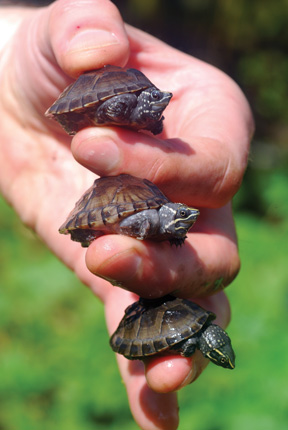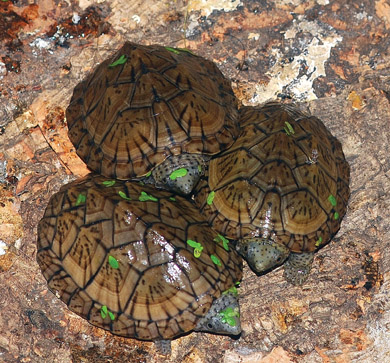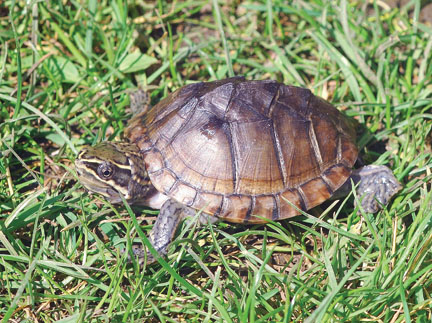
The
Care and Breeding of Musk Turtles

Dr. Mark C. Webb
Introduction
Recently, hatchling musk turtles seem to be turning up for sale in pet shops, reptile shops and aquatic centres with increasing regularity. In some ways, I see this as a good thing, in the sense that these turtles are far more suitable for home keeping than many other species usually offered, like sliders, cooters, snapping and softshell turtles. All of these latter turtles grow large, in some cases require fairly specialist captive conditions, and so keeping them properly is beyond many keepers. Musk turtles, on the other hand, are small in size and are relatively easy to keep. They might lack the bright colours of some of the sliders and cooters, but in my opinion they more than make up for this in terms of personality – these are small turtles big on charisma!
Unfortunately however, much of the time they are sold with incorrect care information and although there are good reference books available, these are often out of print and/or relatively hard to get hold of, and are not as widely read as they might be. Given their increased availability in shops, and the misinformation often supplied at point of sale, I suspect that musk turtles will start being offered for rehoming much more than in the past.
The common name “musk turtle” is given to turtles in the genus Sternotherus of the turtle family Kinosternidae, which also includes the mud turtles. There are five species/subspecies, all of which are found in North America. These are the common or stinkpot musk, S. odoratus, the razorback musk S. carinatus, the loggerhead musk S. minor minor, the stripenecked musk S. minor peltifer and the flattened musk S. depressus. These last two are very rare (stripenecked) or nonexistent (flattened) in captivity and so this article only considers the first three: stinkpots, razorbacks and loggerheads. Of these, the first two are by far the most commonly offered for sale.

In the wild, stinkpots range from New England and southern Ontario (Canada), south to Florida and west to central Wisconsin and west Texas. Razorbacks range from southeastern Oklahoma, central Arkansas and Mississippi south to the Gulf of Mexico; their range is almost completely within the Gulf Coastal Plain. Loggerheads range from southwestern Virginia, eastern Tennessee, and central Georgia south to central Florida and west to the Pearl River system in southcentral Mississippi (Ernst, Altenberg and Barbour, Turtles of the World website). From these distributions, you can see that stinkpots (from the northern part of their range) have the potential to be extremely cold tolerant, although razorbacks and loggerheads come from warmer waters.
All three of these musk turtle species have (broadly) oval carapaces, with a central/dorsal keel being present in loggerheads and particularly razorbacks. Razorbacks can reach a carapace length of 16cm (ca. 6 inches). Loggerheads and stinkpots are a little smaller, and stay at around 13.5cm (ca. 4 to 5 inches). Stinkpots are perhaps the least attractively marked, with plain brown/green carapaces. Razorbacks and loggerheads have cream to sandy brown carapaces peppered with black dots and streaks. In fact telling these two apart can be difficult, and relies on the presence of a tiny gular scute on the plastron, present in loggerheads and absent in razorbacks, although the huge heads of adult loggerheads, especially in the males, are a give away. In fact, all adult musk turtles have relatively large heads with powerful jaws. This is thought to reflect a changing diet that is related to size; as they grow larger they switch from a largely insectivorous (insect eating) diet to a molluscivorous (snail eating) one.

In my experience, hatchling razorbacks are a little shyer than the other two species, but this shyness seems to gradually disappear after a few months.
What’s in a name?
I know that some people are put off these lovely little turtles by their names: how bad do stinkpots stink? In fact, they can release musky smelling chemicals as a form of antipredator deterrent, but although this might not taste good to a raccoon or mink with one in its mouth, this is actually quite a mild odour and they only musk when being molested. Musk turtles (or any turtles) are not really ‘touchy feely’ animals, but they will tolerate light handling without musking their owner and I have never heard of this being an issue at all amongst musk turtle keepers.
Captive habitat:
Hatchling musk turtles start off small; little bigger than a thumbnail. Despite their small size, they are full of beans from the get go, and, providing their basic care requirements are met, they are not at all difficult to raise.
Given their small size, in my view it is not necessary to try and raise hatchling musk turtles in large aquaria or similar. It is safer, and they are easier to observe, in smaller containers, at least for the first six to twelve months.
Another thing to consider is that musk turtles are what are often known as ‘bottom walkers’ – they like to walk around on the bottom of their enclosure, exploring underwater debris, always on the look out for food. They are not particularly strong swimmers, and for hatchlings especially, it is important that they are kept in shallow water. This contrasts strongly with some of the advice given out by aquatic centres and the like; they are sometimes sold for inclusion in normal tropical fish tanks!
I keep hatchling musk turtles in small plastic tubs in approximately 10 or 12cm of water. I add a few river cobbles, a small piece of (floating) rough cork, a large handful of Egeria densa (an easy to grow aquarium plant, often sold as Elodea) and some duckweed. As they hail from temperate North America, they do not require an aquarium heater in my warm reptile room. If they are kept in a room with low ambient temperatures, then there are low wattage aquarium heaters available, including those sold for very small ‘Nano’ aquaria (such as those made by NeoWattino). Alternatively, part of their tub (no more than a third) could be sat on a heat mat turned down to a low setting using an appropriate thermostat. Aim for water temperatures in the range of 20 – 23°C for hatchling stinkpots and 23 25°C for hatchling razorbacks and loggerheads, although none of the turtles seem to be overly sensitive about water temperature.
I then arrange a small, low wattage desk lamp overhead, shining onto the cork. This is plugged into a timer set to come on for around 12 hours a day. The turtles will climb onto the cork at times to bask, but also to rest at night. Basking temperatures should be in the region of 28 32°C. These are not real ‘basking turtles’, like the sunworshipping sliders and cooters, but they will leave the water from time to time if given the chance, and I see it as important to allow them to.
Of course it is possible to keep hatchling musk turtles in large aquaria, as long as the water is kept shallow. One advantage of this is that an aquarium filter can be included, perhaps an internal power filter laid on its side, or even an external power filter. My method does not include a filter, and so it relies on very regular partial water changes.
In larger tanks it is important to include some bogwood, stones and live aquatic plants, so that they can climb towards the surface and rest in such a way that they can stretch their heads above water without having to tread water. Also, filters need to be adjusted to reduce their flow rate – remember that they are not strong swimmers and they come from still or slow moving waters they will not appreciate fast currents caused by powerful filters.
Given their small adult size, it is acceptable to keep a single adult in an aquarium or tub of approximately 60cm x 37.5cm wide (i.e. 24” long x 15” wide), with a tank of say 90 to 120cm long x 45cm wide (i.e. 36” to 48” long x 18” wide) wide for a pair or trio. Standard aquariums tend to be narrower and taller, and so you may have to order a wider tank specially. Alternatively, containers like plasterer’s baths can be put to good use. If you do, bear in mind that whilst the turtles will be absolutely fine in these sort of containers (and they are cheap), they do have the disadvantage that you will see a lot less of your charges.
Feeding:
This is probably the best part of turtle keeping and in this regard, musk turtles do not disappoint – they like nothing more than food! Musk turtles are omnivorous, and in the wild they include at least some plant material in their diets. In captivity however, they are normally almost exclusively carnivorous. I have a small group of young stinkpots from Florida who seem to devour duckweed, but this is by no means universal behaviour. Nonetheless it is a good idea to include some duckweed Lemna spp. and other aquatic plants within their enclosure, giving them the opportunity to eat plant material.
Hatchlings enjoy (thawed) frozen fish foods, including bloodworm, krill, chopped mussel, chopped cockle and Ruto’s Turtle Food. They also relish finely chopped fresh or (thawed) frozen fish of any kind. For reasons relating to toxicity in reptiles, and because of their salt content, they should not be fed too often on marine fish like whitebait. Freshwater fish like trout and salmon are perfectly safe however. It is also important to introduce a good quality commercial turtle pellet food like Tetra’s Reptomin or Sera’s Raffy P. Pellets can be presoaked in a little tank water to let them soften before feeding. It can take some musk turtles a little while to get used to these but there are definite benefits in a little perseverance as these pellets are enriched with vitamins and minerals, including vitamin D3 and calcium; essential components in the diet of reptiles.
The final component of their captive diet is live food in the form of invertebrates. Musk turtles relish these and to me they form an important part of their diet. Lesser mealworms, mealworms (chopped for tiny hatchlings), small crickets, small roaches and chopped earthworms are all devoured with gusto. It is best to feed hatchlings a little and often, at least daily, rotating different food items so that they get a balanced diet and don’t get ‘hooked’ on any one type of food. If you have more than one musk turtle housed together, it is a good idea to introduce food in more than one location, so that they can feed separately, otherwise they may well fight over every morsel! I’ve never seen them come to harm doing this, but it is good to make sure that each turtle gets a decent meal.
I have found the keeping of musk turtles rewarding and not too demanding. I have small groups of stinkpots, loggerhead and razorback musks in my collection and hopefully at some point in the future will be able to report some captive breeding experiences.
Further reading:
There may well be other texts available but three books that I know give good general information about keeping turtles and also reliable information about musk turtles are Russ Gurley’s Keeping and Breeding Freshwater Turtles (now out of print but available second hand from US online booksellers), Richard Lunsford’s Captive Care of North American Water Turtles (available as a free download or you can buy a paperback copy) and Andy Highfield’s Practical Encyclopaedia of Keeping and Breeding Tortoises and Freshwater Turtles
Acknowledgements:
Thanks to Mark Witherall for taking the photographs which accompany this article and my previous article about painted wood turtles.
References:
Ernst, C.H., Altenburg, R.G.M and Barbour,
R.W. Turtles of the World website.
(c) 2010 Tortoise Trust